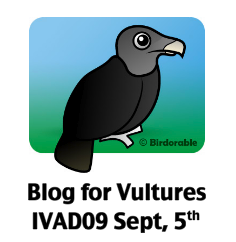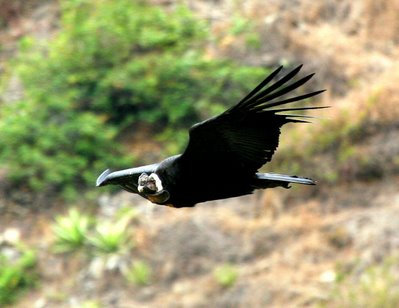Vulture day. Flaps, what we gonna do?
Biography Vultures
Today is International Vulture Awareness Day and this is my contribution to the IVAD09 blog festival Since my childhood I have always loved vultures. Kind of strange as there are no vultures in Sweden. But all those savanna nature films with several species of vultures shown and the “Fauna” collectable animal enciclopedia by the Spanish filmer and pioeneer Felix Rodrigues de la Fuente – worthy a blog post on his own – completely had me. My interest totally toppled with the above scene from the Jungle book – which unfortunately is cut off but continues……
Buzzy: Oh, blimey, there you go again. The same once again!
Ziggy: I’ve got it! This time, I’ve really got it.
Buzzy: So you got it. So what we gonna do?
Dizzy: Hold it lads. Look, look what’s coming our way.
Flaps: Hey, what in the world is that?
Ziggy: What a crazy looking bunch of bones.
Dizzy: Yeah, and the’re all walking about by themselves [They look at Mowgli who sits down on a stone]
Buzzy: So what we gonna do?
Flaps: I don’t know– and now don’t start that again!
Ziggy: Come on lads, come one let’s have some fun with this little fella, this little [flockey?] [They all fly down to Mowgli]
Flaps: Blimey, he’s got legs like a storky.
Buzzy: Like a stork, heh-heh, but he ain’t got no feathers.
I started guiding for a Swedish nature tour company called Temaresor in the late 80s and in the years to come I managed to get trips where I could see vultures live. It was like the books and films of Felix came alive. Here are some highlights.
- Breeding Griffon Vultures in the Cevennes, France
- Impressive Griffon Vulture migration at Tarifa, Spain
- Lammergeir in the Spanish Pyrenees
- Several species of vultures just like I pictured over a dead Zebra in Tanzania
- Most of the severely threatened Indian sub-continent vultures in Nepal and Dehli, India.
Eventually, I ended up in South America and got to see vultures here as well . Although the New World vultures (derived from stork ancestry NOT. Newer data suggests, as David Ringer points out in his blog that they are not close to storks after all, but rather should be treated like a seperate group close to Falconidae.) are not related to the old world vultures (derived from hawk-raptor ancestry) they share similar biology. The are all highly social species who find their food spottily but in large concentrations. A carcass can feed several individuals so there is plenty of food for many. Therefore, vultures have developed systems of visual cues to let other individuals know that there is a food resource nearby. It can for instance be set off by the way a vulture descends to a spotted carcass. Vultures fly high not only because they can spot food from a far with their excellent eyesight, but also so they can see what the other vultures do.
The species in the Cathartes genus (Turkey Vulture and Greater Yellow-headed Vulture) can sense smell, which is unusual with birds in general (but shared with for example the Marabu Stork). Therefore, other species such as Condor and King Vulture will always keep an eye on visual cues from the Turkey Vultures and the Yellow-heads.
One of my best moments of guiding involving vultures was at Paracas on the desert coast of Peru. A group of Swedish non-birders made an excursion to the Paracas peninsula to view sea-lions and flamingos. It was a beautiful afternoon with soft warm sunlight playing with the pastel colors of the desert sand dunes. All of a sudden a woman exclaimed.
Gunnar! There is a huge black bird out there with a bright red head. It is beautiful!!!
Yes, she had seen the Turkey Vulture. From that moment I realized that it is much more rewarding for a guide showing birds to non-birders than to birders. Birders often forget to see the beautiful in the common and the trivial.
The vultures in Peru has been subject of persecution. A couple of years ago they had to suspend all day flights to Iquitos in Loreto department in the middle of the Amazon rain forest, because the “highly intelligent” politicians in Iquitos had granted permission to build a garbage dump next to the airport. What were they thinking? The result, of course -risk of collisions and flights needed to fly in very early before the thermals or in the evening.
The officials tried eradication campaigns (yes…vulture slaughter)…but soon had to realize that it did not fix the problem. Recruitment of new vultures flying in from other parts of the jungle was always swift. Eventually, the dump was moved…..to the other side of the road across from the Allpahuayo-Mishana reserve, threatening polluting the ground water in the area. Fix one problem and create another is very common in Peru.
The Condor.
The condor is not doing well in Peru. In many suitable areas it is strangely absent. One can only deduce that the persecution one hears about – poisened carcasses and direct hunting – is frequent. In spite of more environmental aware population in general, in areas where livestock are held and especially where there is a thriving alpaca and vicuña wool industry, the Puma will be seen as the most abominable of all creatures. Also the Condor is suspected to kill, in spite that the biologists say they only eat dead animals. The locals describe Condors harassing young livestock pecking their eyes and anus (soft parts) to such extent that the animal become weakened and dies. On one tour some years ago one of our clients, Kelly Cotten of Texas witnessed this on a hike near Abra Malaga in Cusco. It should teach us to listen more to the locals!
On one occasion guiding again a group on non-birders, I was asked by the group members as we headed to Machu Picchu whether we would see any condors during our visit. I said: Nah, it is a bit too low and warm for condors at 2000m and furthermore the whole area is covered by forest. It is not really Condor habitat. The day of our visit to the Machu Picchu citadel high above the Urubamba river that snaked below the clouds were low. We could still see the famous profile of the sugar loaf Wayna Picchu mountain in front of us, but the higher peaks of more than 3000 meters were covered in clouds.
All of a sudden I hear my clients commenting in front of me as we climbed to the Inti Huatana – the famous sun dial hitching pole rock sculpture:
– Hey look! What a big bird! Is it an eagle?
– No, I think it is condor, said the second client.
– No, it can’t be, because Gunnar said it does not occur here
Right! Birds fly and on this overcast day they couldn’t see nada higher up. Two condors, an adult and an immature, flew across the Huayna Picchu background. Stunning! And everybody awed!
Andean Condor needs conservation
A way to see if there is a healthy condor population is counting adults vs immatures. It takes 6 years for the condor to acquire full breeding plumage. If the ratio is 1:1 the it is a stable population. However, if the ratio gives more adults than juveniles it means there is high juvenile die-off before maturity which concludes that the overall population is decreasing.
It was so much more refreshing after many trips up the Santa Eulalia Canyon 3hours from Lima to find that the population of condors is significant and with many immatures. Read more about the condors in Santa Eulalia Canyon here.
I have been pushing for, without much success I am afraid, that the condor ought to be the national bird for Peru and Condor Pasa the national anthem. That would help sell Peru in the world wouldn’t you think? Hand on heart, in spite of the Condor being present in many countries, which country do you think of when Condor is mentioned in an Andean context. Or the other way around, what bird comes to mind to anyone – birder or non-birder – when somebody says Peru?
Lifting the Condor to national bird would both help its conservation and become a poster species for tourism.


